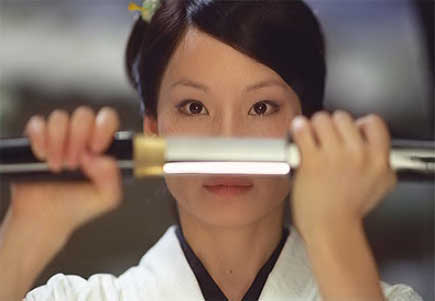

“Lady Snowblood” (1973) ranks as one of the classics of Japanese action cinema, and is perhaps one of the most influential female action films ever made. Despite its vintage, this film set in the final years of the 19th Century during the Meiji Restoration still retains incredible power and beauty. Its timelessness owes much to the theme of vengeance delivered long after the original crime, rendered with immaculate and exquisite self-control by Meiko Kaji in the lead role as “Yuki Kashima.” It should be clearly understood that “Lady Snowblood” appears to be the single greatest influence on “Kill Bill.” While numerous other cinematic references may be discerned, “Lady Snowblood” supplies the essential narrative and inspires the mise-en-scene of “Kill Bill’s” most effective moments. It has also been identified as one of Tarantino’s favorite vengeance films.
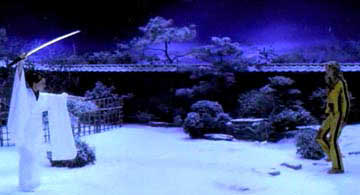
In brief, “Yuki’s” father and brother are killed and her mother raped by a ruthless gang of four swindlers before she is even conceived. After killing one of her assailants during subsequent forced intercourse, “Yuki’s” mother is incarcerated and conceives her to raise an heir who will avenge her family. “Yuki’s” mother dies giving birth to her, and the child is raised by a monk who trains her in the art of ninjutsu. As a young adult she makes a living as an assassin, all the while seeking the three surviving assailants who are now older and settled in middle age.


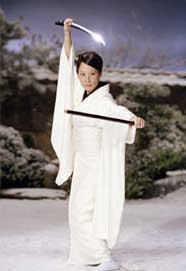
It seems evident that “Kill Bill” sought to capture the defining features of “Snowblood” and its lesser-known sequel “Love Song of Vengeance” in its scenes of combat pitting a female swordswoman against multiple male opponents, geysering blood and severed limbs, use of costume ball masks, a climactic battle in a place of entertainment with a grid floor pattern filmed from above, and a final scene played out at dusk in the intimacy of a quiet, outdoor space amid the newly fallen snow. “Snowblood” includes chapter boards and an invitation to future vengeance made by “Yuki” to the daughter of one of her victims. There is also a close-up of Meiko Kaji’s toes. Any remaining doubts are removed by the use of the original haunting theme from “Lady Snowblood” (sung by Meiko Kaji) and the obvious physical resemblance between “Yuki” and Lucy Liu’s “O-Ren Ishii” in “Kill Bill.”
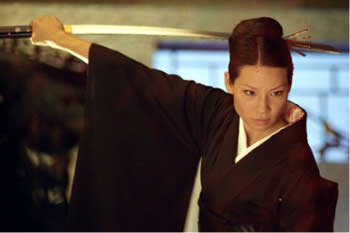
Although Tarantino and cinematographer Bob Richardson masterfully recreate and improve on the mise-en-scene of the end of “Lady Snowblood” during the Japanese snow garden scene of “Kill Bill,” the carefully recreated symbolism is squandered. As “O-Ren Ishii’s” blood trickles over her immaculately white clothing onto the virgin snow, this powerfully invites identification with her. Liu’s performance bears the legacy of “Snowblood,” not Thurman’s. Her character’s backstory most closely resembles “Yuki’s.” Within a culturally appropriate frame, her character’s actions are perfectly honorable. Reviewers who have commented on the seeming sexual implication of the trickling blood onto the virgin snow can obviously read the film in this manner, but this defies the logic and content invoked by the very clear reference to the original. The scene clearly suggests cleansing for “Yuki” – and, by extension, “O-Ren Ishii.” To have remained faithful to the spirit of the original, “O-Ren Ishii” should have triumphed – or at least undergone a transforming culmination. Instead, “Kill Bill” presents us only with a brief Western-style apology to “The Bride.”
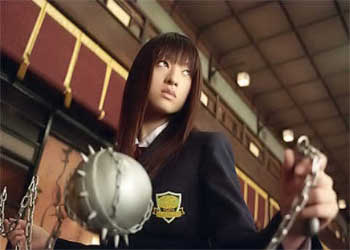
“The Princess Blade” (2002), Shinsuke Sato’s re-make of “Lady Snowblood” (both films are entitled “Shurayukihime” in Japanese) avoided such pitfalls by successfully updating the story to the near-future while maintaining spiritual continuity with the original. In “Princess Blade,” Yuki is played by J-pop star Yumiko Shaku whose combat boots, T-shirt and torn leathers are the garb of a postmodern heroine. But her wistful puzzlement and attachment to a musical locket – one of the few mementos of her murdered mother – suggest a yearning for emotional grounding to something besides a clan of assassins. As Shaku’s “Yuki” identifies her mother’s killers and exacts her vengeance there are ample opportunities for fetishistic katana worship as well as hints of transgressive relations. “Yuki’s” female rival in the assassin clan knocks her down, kicks her into immobility, then pierces her hand with a katana, pinning her to the ground. She then licks blood from “Yuki’s” face. Continuity with the spirit of “Shurayukihime” is provided by scenes of “Yuki” wearing white framed by intensely sunlit scenery – virtually surreal in its brilliance – as well as washing rituals at a lakeside. After being almost killed on two occasions, a copiously bleeding “Yuki” seeks refuge at the dwelling of a retired terrorist. Although “Yuki” gradually discovers warmth and humanity as she recovers and in turn helps him and his severely traumatized mute sister, the film’s resolution is distinctively different from Western action conventions. As “Yuki” does solitary battle and takes her final vengeance, those who helped her and provided a potential bridge to a better life are brutally killed.
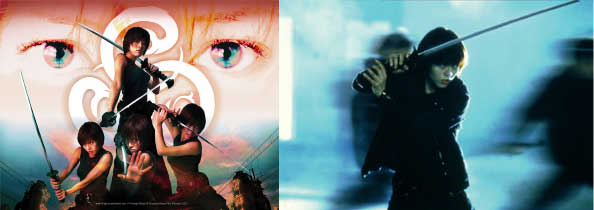
In the film’s final scene “Yuki” stands alone at the lakeside, contemplating her katana. A Western film might have her throw this instrument of death into the water. But she does not, instead raising it in salute. It is exactly as her former foes predicted. She is programmed to kill and cannot avoid her fate. As “Yuki” says earlier in response to an inquiry about her motivation for killing, “My body just moves.” This puzzles her – she really does not understand how her body “just moves” – and her search for enlightenment culminates in the small recognition that it is important to have someone to pass something of oneself along to, even if only in memory.
All written material copyrights
by T. P. (2003)